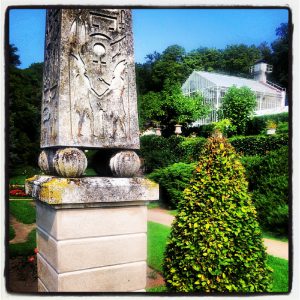Konopiště Chateau and Archduke Franz Ferdinand d’Este
By Tracy A. Burns
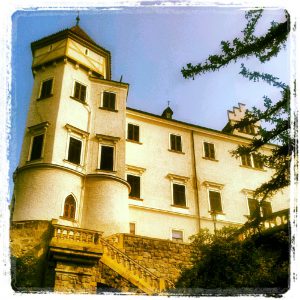 History of the chateau until the 19th century
History of the chateau until the 19th century
Konopiště was founded in the late 13th century as a Gothic castle inspired by the style of French castles with seven stouts, rounded towers and five gates. In 1327 Zdeslav of Šternberk took possession of the castle, and it would stay in his family for more than 275 years. Unlike many other Czech fortifications, Konopiště has not damaged during the 15th-century Hussite wars. During the late 15th century, George of Šternberk remodeled the castle in Gothic-Renaissance style, adding vaulted ceilings and gardens. After the Lords of Hodějov purchased the castle in 1602, the place was transformed into a Renaissance residence. Several other owners came and went, and the chateau was immensely damaged during the Thirty Years’ War. Konopiště was in bad condition when it was sold to the Czech kingdom’s highest burgrave, Jan Josef of Vrtba, who remodeled the chateau into an opulent Baroque residence. Under the ownership of František Václav Vrtba, the chateau was decorated with Rococo elements. The ceiling fresco was created in the Great Dining Hall, and Rococo-Gothic woodcarvings found a home in the chapel.
History of the chateau from the 19th century to the present
During the late 19th century, Konopiště came into the hands of the 24-year-old Franz Ferdinand d’Este, the oldest nephew of Austrian Emperor Francis Josef I and later heir to the Habsburg throne. He made many changes to the interior and remodeled the chateau so that part resembled a Renaissance residence in North Italian style while another section sported a medieval look. He installed much advanced technical equipment, including central heating and electric lights as well as an electric elevator. Franz Ferdinand also established the Rose Garden and furnished the armory. His collection of hunting trophies and Saint George-related items also appeared in the chateau. The chateau park was enhanced with masterful sculptures. After his assassination in June of 1914, the property was taken over by the Hohenbergs, and the chateau was nationalized in 1921. After World War I, it was plundered and during World War II, Konopiště became a SS headquarters. The state took over in 1945, and now the Central Bohemian Institute for Preservation of Historic Monuments in Prague looks after the chateau.
Archduke Franz Ferdinand d’Este
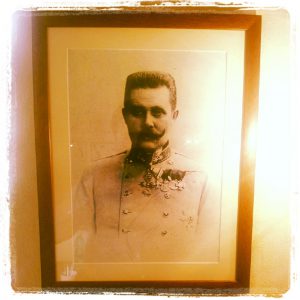 Born in 1863, Franz Ferdinand was the eldest son of Archduke Karl Ludwig of Austria, the brother of Emperor Franz Josef I. After his cousin, Crown Prince Rudolf committed suicide and his father died, Franz Ferdinand became heir to the Habsburg throne. The Archduke had a distinguished military career but was not very popular with the Empire’s leaders because he sought to give more freedom to the ethnic groups in the Austro-Hungarian Empire and promoted federalism that would break the empire into 16 states.
Born in 1863, Franz Ferdinand was the eldest son of Archduke Karl Ludwig of Austria, the brother of Emperor Franz Josef I. After his cousin, Crown Prince Rudolf committed suicide and his father died, Franz Ferdinand became heir to the Habsburg throne. The Archduke had a distinguished military career but was not very popular with the Empire’s leaders because he sought to give more freedom to the ethnic groups in the Austro-Hungarian Empire and promoted federalism that would break the empire into 16 states.
Marrying Sophie
The emperor strongly disapproved of Ferdinand marrying Sophie Chotková because no one in her family was a descendent of the Habsburgs or of any other European ruling dynasty. The couple kept their relationship a secret for two years. Finally, Emperor Franz Josef I consented, and the couple married in 1900, though notably absent from the ceremony were the emperor, archdukes, and Ferdinand’s brothers. Also, Franz Josef I, asserted that their offspring could not be heirs to the throne. During their 14 years of marriage, Sophie was never allowed to share her husband’s rank or title. They had three children.
The assassination
During the summer of 1914, as Inspector General of the Army, Franz Ferdinand, accompanied by his wife, went to oversee military maneuvers in Sarajevo, Bosnia, which, along with Herzegovina, had been annexed by Austria in 1908. On June 28, 1914, Gavrilo Princip, an assassin affiliated with the Black Hand terrorist group that wanted to liberate the south-Slav provinces from Habsburg rule, shot and killed the Archduke and his wife in their car. Less than two months later, World War I began. The bullet that killed the Archduke is at Konopiště.
The funeral and burial
While the couple was given a joint funeral, the Habsburgs made sure that Sophie was just as humiliated in death as she had been in life. She was placed on a bier that was 18 inches lower than her husband’s. Furthermore, gloves representing her days as an Imperial lady-in-waiting were put on her coffin. They were buried in the crypt of their country home at Artstetten Castle in Austria.
Literary reference
Prolific early 20th-century Czech writer Jaroslav Hašek mentions Franz Ferdinand and Konopiště as well as the seven shots that Princip fired in his literary masterpiece, The Good Soldier Švejk and His Fortunes in the World War, a farcical novel sprinkled with anecdotes.
The first tour of the chateau
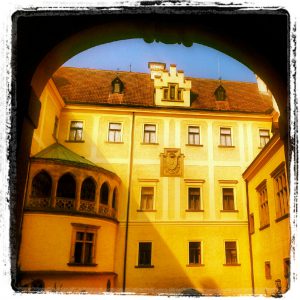 A hunting enthusiast, the Archduke went on hunting expeditions in South Africa, Egypt, Australia, and India, to name a few places. Some 4,500 hunting trophies and 3,200 pairs of deer teeth decorate the chateau. The first tour covers representative rooms as well as official and social rooms. The Rose Room, adorned with a pink ceiling and white stucco, includes 19th-century Rococo furniture along with a stunning Czech crystal chandelier. A wedding gift for Franz Ferdinand and Sophie, the Empire-style circular table is decorated with gemstones and hails from Venice. In another room, three marble Italian cabinets made in Florence in 1680 enthrall with floral and bird motifs.
A hunting enthusiast, the Archduke went on hunting expeditions in South Africa, Egypt, Australia, and India, to name a few places. Some 4,500 hunting trophies and 3,200 pairs of deer teeth decorate the chateau. The first tour covers representative rooms as well as official and social rooms. The Rose Room, adorned with a pink ceiling and white stucco, includes 19th-century Rococo furniture along with a stunning Czech crystal chandelier. A wedding gift for Franz Ferdinand and Sophie, the Empire-style circular table is decorated with gemstones and hails from Venice. In another room, three marble Italian cabinets made in Florence in 1680 enthrall with floral and bird motifs.
Other rooms on the first tour
In the Grand Dining Room, a Baroque ceiling fresco dominates. In the allegory of the four parts of a day, the fresco shows off Dionysus, the Greek god of wine, at a wild feast. The biggest Czech crystal chandelier in the chateau, weighing 170 kilograms, can be found here. Decorative carvings adorn the walls. In Trpitz’s Bedroom, a 19th-century Murano chandelier boasts pink and green glass flower buds. William II’s Bedroom includes paintings dating from the second half of the 15th century, such as a brightly colored rendition of the death of the Virgin Mary from Italy in 1496.
The second tour of the chateau
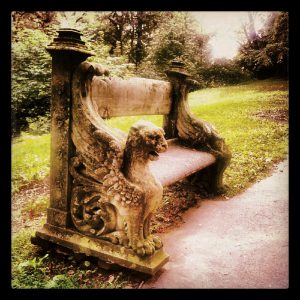 The second tour shows visitors the oldest part of the castle, and its highlights are the chapel and armory. The 16th-century Renaissance vaulting throughout the spaces is magnificent. The chapel’s 19th-century vaulted ceiling representing the night sky is painted blue with gold stars. In the neo-Gothic main altar, the Virgin Mary and Jesus take center stage, flanked by Saint Hubert and Saint George. The 15th and 16th-century paintings and sculptures enchant with vibrant, dynamic colors. The armory is one of the biggest in Central Europe. The 15th and 16th century Renaissance sets of knights’ armor sport holes from sharp heads of spears. Rifles and pistols hail from 16th and 17th century Germany, Italy, France, and the Silesia region of what is now the Czech Republic. One piece of armor for a knight is designed for a six to an eight-year-old child. Rapiers and swords also make appearances in the collection.
The second tour shows visitors the oldest part of the castle, and its highlights are the chapel and armory. The 16th-century Renaissance vaulting throughout the spaces is magnificent. The chapel’s 19th-century vaulted ceiling representing the night sky is painted blue with gold stars. In the neo-Gothic main altar, the Virgin Mary and Jesus take center stage, flanked by Saint Hubert and Saint George. The 15th and 16th-century paintings and sculptures enchant with vibrant, dynamic colors. The armory is one of the biggest in Central Europe. The 15th and 16th century Renaissance sets of knights’ armor sport holes from sharp heads of spears. Rifles and pistols hail from 16th and 17th century Germany, Italy, France, and the Silesia region of what is now the Czech Republic. One piece of armor for a knight is designed for a six to an eight-year-old child. Rapiers and swords also make appearances in the collection.
More intriguing aspects of the second tour
In another room, a chandelier in Nuremberg style is adorned with deer antlers. A table inlaid with ebony shows off intarsia and is decorated with a hunting motif. There is also an electric elevator with comfortable seat cushions inside. The library includes 3,000 volumes in German, Italian and Latin. A portrait of Sophie in a dark green dress shows her holding pink roses. Part of an elephant’s foot was used as an ashtray. A 16th-century tapestry featuring King of Macedon Alexander the Great hangs in the Smoking Salon along with a 17th-century marble fireplace decorated with figures of lions and coats-of-arms. The stuffed and mounted bear there inhabited the moat until her death in 2007. Now another bear roams through the moat.
The third tour
The one-hour third tour gives visitors an excellent opportunity to see how Franz Ferdinand and his family lived and is perhaps the most intriguing of the three. It includes 15 rooms of Franz Ferdinand’s private apartments with furniture of various styles, all decorated as they looked when Franz Ferdinand lived there with his wife and three children. Portraits of prominent figures line one hall. Look for Christopher Columbus and Michelangelo. Three wooden, Nuremberg-style chandeliers adorned with deer antlers decorate a hallway. A 15th-century Madonna and Child painting hang over the archduke’s bed. Many pieces of furniture as well as two jewelry boxes feature intarsia. A lighter is shaped like a dog. Graphic sheets sport hunting themes. A brightly-colored Renaissance tiled stove mixes blues with greens and gold. A chandelier from Murano boasts pink, white, blue, and yellow flower buds. In a bedroom, there is the congratulatory telegram that Emperor Franz Joseph sent to his nephew when their oldest child, daughter Sophie, was born. Even the bullet that killed Franz Ferdinand’s wife is on display as are the couple’s death masks. Photos from Franz Ferdinand’s trip around the world also are sure to enthrall. Artifacts dealing with his military career are exhibited, too
Other attractions
The Archduke’s game room and shooting range are another attraction along with a museum devoted to Saint George memorabilia that Franz Ferdinand collected. In the museum dedicated to Saint George, there are numerous statues, paintings, altarpieces, ceramics, and glasses showing the saint killing the dragon. A vast park boasts a rose garden with many Italian sculptures and hothouses with exotic plants.

